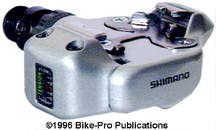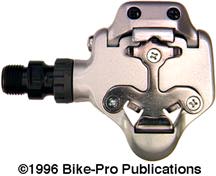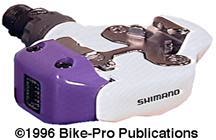Brake Systems
- Brake/Shift Levers
- Caliper Brakes (Road)
- Cantilever Brakes (MTB)
- Brake Levers
- Brake Shifter Combination Levers
- Brake Boosters
- Brake Cables
- Brake Carriers
- Brake Hangers
- Brake Pads
- Titanium Brake Hardware
Computers
Cranks and Chainrings
Forks
Frames & Framesets
Freewheels and Cassettes
Front Derailleurs
Grips
Handlebars
Handlebar Extensions
Headsets
Helmets
Hubs and Skewers
Lubricants
Metal Guide - Bicycle Metallurgy
Mirrors
Pedals and Toe Clips
Pumps and Inflation Systems
Racks
Rear Derailleurs
Rims & Rimstrips
Saddles
Seatposts and Binder Bolts
SRP Replacement Titanium &
Aluminum parts - Master Index
Stems
Tires
Tubes
Shoes
Spokes (Tables Only)
Tools - Bicycle Repair Tools
Yakima Fit List -to fit all cars
Notes
Links
Home
Shimano SPD Pedals
SHIMANO SPD ROAD AND MOUNTAIN BICYCLE CLIPLESS SYSTEM - An Overview
At the time when other makers were executing the idea of a toe clipless style pedal with a cleat locking into the pedal top, or modifying a ski binding system, Shimano was conceiving their concept of a clipless pedal. The Shimano system uses a small, recessed steel cleat, rather than the plastic protruding ones used by others, so there isn't a tendency for them to abrade in use and have to be replaced so often. Another consideration was to make the cleat small enough so that it could recess into the sole of the cyclist's shoe. Recessed cleats allow the rider to walk on the shoes with cleats installed, yet not be bothered by a large plastic protruding cleat or make it sound as though you had horse hooves. Their final consideration was to vary the style of disengagement, and make the retention system adjustable. Shimano has achieved all of these. The cleat itself is just a little over 1 1/4" square and 1/4" thick weighing just 19 grams. Because it's a micro-cleat, having it recess into shoes was fairly simple, and shoe makers other than Shimano make shoes to use with this recessed micro-cleat system. These are referred to as "SPD compatible shoes". Shimano's retention system is adjustable in the amount of tension required before it will release the shoe from the pedal. To vary the style of disengagement, Shimano has two types of SPD cleats, each with tow style of disengagement. The one that comes with all their pedal sets is the SM-SH50 (MTB) or SM-SH70 (Road). They are Black in color, made of forged steel, and will permit your foot to release only with lateral motion by twisting your foot away from the pedal horizontally. The other cleat is the SM-SH55 (MTB), or SM-SH71 (Road). It is Silver in color and will permit your foot to release with lateral motion, or sharp vertical motion, or even a twisting diagonal upward movement of the shoe. The SM-SH55 is available only as an aftermarket replacement for the SH-50 pair that come as original equipment with their pedals. Incidentally, the difference between the two types is the depth of the notches that the clamps grip on the upper side of the cleat. The notches are considerably shallower on the Silver SH-55 or SM-SH71 set, making the grip slightly less precise and allowing release at various angles. You can adjust the cleat for your perfect comfort because the Shimano cleats, when mounted, are adjustable front to back, by up to 3/4" (depending on the shoe) and laterally on the shoe bottom by up to 3/8". The cleat rests on the pedal inside a steel "saddle" made with four vertical tabs to assist in positioning it. The two rear tabs are bent outward slightly to permit release and accent the movement of your foot, in a way the retention system interprets as "intent to release". The cleat is held in the retention system by a point at the front that slides under a steel clamp. The rear of the cleat has a blunted tip that drops into a rear spring loaded clamp that has a tension adjusting bolt. The tension bolt is turned with a 3mm allen wrench clockwise to increase the spring tension, and counter clockwise to decrease it. There is a detent at each third of a revolution, so you can count the adjustment with 1/3 turn precision and repeat it on the other pedal so they are equally tensioned. There is also a visual indicator of how tight the spring is set, by the movement of a red dot on a nut, on the adjusting screw. This dot moves as you rotate the adjusting screw, for a rough visual sense of the spring tension. As an aside, the front cleat clamp is also spring loaded on the M737 pedal, though it's tension isn't adjustable it makes entry easier. The bottom of each of the points on the cleat is rounded so that it easily finds it's way into the steel "cradle" that holds it. With downward pressure, the steel spring clmap moves aside permitting the cleat to drop in and be held by the clamps. The clipless mechanism itself, isn't nearly as complicated as you imagine it to be, before really examining it. The variations in the pedals have to do with the reversible nature, or lack of it, retention clamp springs and materials. Starting in 1994 Shimano began to sell their SPD pedal sets directly to retailers. They previously had wholesale organizations stock and sell to retailers, creating price competition that held or drove prices downward. It is widely believed that with the direct sales to retailers, Shimano will eventually institute a form of retail price maintenance. It is believed that Shimano will insist everyone sell the pedals at a specific price or not receive future deliveries (as they have tried to do with their SPD shoes for the past several years, which is why you don't see their shoes sold on a mail order basis). The next perceived step will be the cessation of mail order sales. More than a few people believe that Shimano will eventually be dealer-direct, with an enforced price structure for the sales of all parts. When the designers who specify the parts that go on bikes used SPD pedals previously, they had been able to insist that their wholesale organization be able to sell them after- market leading to widspread availablity. With Shimano as the only after- market source, there is less reason for designers to use them as original equipment which is why the Ritchey pedals have become so popular for the 1995 & 1996 model years.
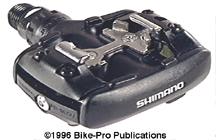
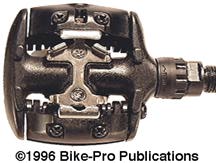
SHIMANO M737 SPD MOUNTAIN CLIPLESS PEDALS
The M737 is Shimano's most expensive mountain clipless pedal, designed for use with the Deore XT and XTR group of components though it will work with any crank and drivechain. The body for this pedal is made of cast aluminum alloy, with tapped threads on the top and bottom for screws that hold the two cleat saddles. The interior of the body has threads for the spindle and bearing to turn into, as a single unit. The M737 is a reversing pedal, with separately adjustable clipless systems on both the top and the bottom, so there is no concern about trying to get the pedal upright to clip into it. One of the suggestions we've heard involved someone setting the top and bottom tensions differently, and marking one side with paint so they could, without adjustment, have the pedals set for two riding styles. One of this pedal's features not on the other SPD pedals is, the front steel clamp which holds the cleat is spring loaded. On the other models it's merely a rigid steel lip. This spring design makes blind entry easier. The housings that enclose the spring assemblies are made of cast aluminum.

The spindle is made of cast Cro-moly steel, that has a threaded nylon "sleeve" or lock nut. This lock nut is what threads into the body. A separate steel bearing race with twelve 2.2mm steel ball bearings for the inner bearing assembly is at the end of the sleeve. A steel tube with cupped ends makes both bearing cups, followed by twelve more 2.2mm bearings and a nutted steel race. The bearings are adjustable. These parts together make a single spindle and bearing assembly that threads into the body. The pedals come with a set of SM- SH50 cleats and their mounting hardware as well as a TL-PD40 spindle/bearing removal tool. The pedals are Black with Silver saddles and retaining clips, the pair weighs 510 grams, and the Black cleat set, with hardware weighs 63 grams. These are no longer made and have been replaced by the 747 which will be reviewed by mid-summer 1995. We sold these for $119.99 a pair.
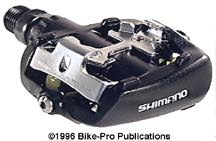
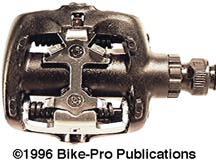
SHIMANO M525 SPD MOUNTAIN CLIPLESS PEDALS
The M525 version of the Shimano SPD pedals is marketed for use with the Deore DX and LX parts, though they can be used with any crank and drivetrain. The body of the pedal is made of cast aluminum, with two tapped holes on the bottom and top to hold the cleat saddle. The interior of the body is tapped with threads for the spindle with all the bearing parts to thread in as a single unit. The M525 is reversible, so both the top and bottom can be "clipped" into without searching for an "up" side. The rear clamp is spring loaded, the front clamp is a part of the saddle structure and therefore rigid. A main difference from the M737 is that you must entr the M525 toe first, while the M737 can be entered with merely downward pressure. The rear clamp has no aluminum housing, as in the M737, and the clamp itself is larger and made of steel. There is the same 3mm allen wrench adjustment for each rear clamp, with the red dot as a visual indicator to show approximate spring tension and to help set the two retention systems (the same or not as you choose). The spindle is made of forged Cro-moly steel and uses the same style of threaded plastic lock nut to load and tighten the bearing assembly that the M737 has. The M525 again uses twelve 2.2mm steel ball bearings for the inner and outer bearing works and uses a steel tube with cupped ends to form the cup races. The bearing tension is adjustable. The gross size of the M525 pedal is slightly smaller than the M737 and the spindle is therefore slightly shorter, they are not interchangable. These have most of the features of the M737 and weigh slightly less. The M525 pedal set comes with SM-SH50 cleats and the mounting hardware required for them, also included is the TL-PD40 spindle/bearing removal tool. The pedals are Black with Silver saddles and retaining clips, the pair weighs 487 grams, and the Black cleat set, with hardware weighs 63 grams. These are no longer made and have been replaced by the M535 which will be reviewed by mid-summer 1995. We sold these for $84.99 a pair. Their sucessor is the M535
SHIMANO A525 SPD ROAD / MOUNTAIN CLIPLESS PEDALS
Introduced in 1992, the A525 is the third pair introduced by Shimano and up to that time, the least expensive set of one sided Road SPD pedals. Unlike the Dura-Ace and Ultegra SPD pedals, the A525 use the SM-SH50/51 series cleats. The price and weight reductions over the other SH50/51 cleated pedals, the M737 and M525, are owed to the fact that these pedals have just one clipless system on each pedal and therefore aren't reversible. It seems that Shimano's intent was that they be used as road pedals providing the "Trojan horse" needed to break their SPD pedal system into the Road market. Remember, Shimano's previous road clipless pedals are based on the French LOOK clipless system and their full strength SPD road pedals use the SH70/71 cleat. But, many mountain bike riders have adopted these pedals for weight and cost reasons, and they were introduced with accents in the young, hip and "in", mountain bike, Lavender color. For mountain use, their drawback is that they are built as a platform type pedal, with no openings from the upper surface of the pedal to the ground, so there is no practical way for dirt or mud to be evacuated from the pedal in use. The body is made of cast aluminum alloy with three tapped holes on the top for the cleat saddle to bolt to, and two other tapped bolt holes for the SPD system itself to bolt to the rear of the body. The interior is tapped with threads for the single unit spindle and bearing assembly to thread into.
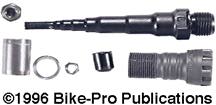
The adjustable spring tension system is housed in a painted Lavender molded aluminum housing. The spring tension is adjustable using a 3mm allen head bolt at the bottom of the SPD mechanism and has a visual tension indicator in the form of a gauged moving red line at the rear of the pedal. The A525 pedal uses the same spindle and bearing assembly found in the M737. The plastic sleeve is molded of Grey rather than Black plastic, and is greased with a milky white grease instead of the clear green grease used in the M737. The Shimano A525 pedals set comes with SM-SH50 cleats and the mounting hardware required for them, also included is the TL-PD40 spindle/bearing removal tool. The pedals are available only in an all Silver finish. The pair weighs 389 1/2 grams. The Black cleat set, with hardware weighs 63 grams.
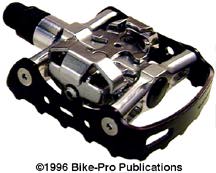
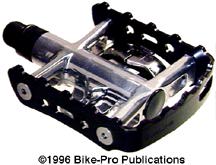
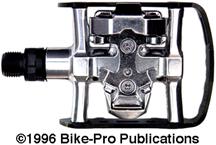
SHIMANO M323 MOUNTAIN CLIPLESS PEDALS
Released in the 1994 season, the M323 pedals reach down with SPD for everybody. The pedal with an identity crisis. Not many people realize, that industry insiders believe that the M323 pedals were intended to be sold only on new bikes, not as after market replacements. The reason for this thinking is that the M323 don't fit into a defined category. They have a forged aluminum pedal body like toe-clip styled pedals have, and a cage that was taken in design and style from the XT Comp pedals. Unlike the Comps, the M323 cage is die- cut from steel then painted Black. The cage is held onto the braces with 4 removable bolts having 3mm heads. The 323s use standard cup and cone race construction with loose ball bearings. The aluminum body has an oversized center, in the form of a platform, for the SPD cleat retention mechanism to be bolted into. The tension on the cleat retention system is adjustable with a 3mm hex wrench. If you want to use the traditional non-SPD side, you must maneuver the pedal to the proper side and then position your foot. At a weight of 539 grams, these weigh more than any other toe-clip pedal, and they weigh slightly more than the clipless M737 so not a light- weight match for an expensive SPD clipless pedal, and they are somewhat heavier than the M525 pedals, though they sell for just $25 less. But when we tell you that they don't come with the needed SH50 series cleats and they will cost you at least $18, you will wonder why you should buy M323s instead of M525s. Now you will understand why industry insiders think they were made for new, complete, factory built bikes only, so that people who haven't used clipless, much less SPD pedals, will only have to spend $18 to get SPD clipless functionality. The pair weight is 539 grams.
